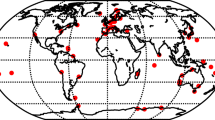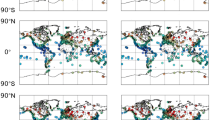Abstract
Global Positioning System technique has been widely used to estimate ocean tide loading displacements, but classical harmonic analysis with satellite modulation typically disregards the effects of hundreds of minor tides within the same tidal species of major tides. We present an improved harmonic analysis of eight major tidal constituents (M2, S2, N2, K2, K1, O1, P1 and Q1) that are adjusted by more adjacent minor tides in semidiurnal and diurnal species than the usual satellite modulation approach, through the tidal admittance interpolation. Our results show that this approach allows for a more reliable determination of GPS-observed N2, Q1, P1 and S2 constituents in the northwest European shelf than the classical method, as demonstrated by a comparison with FES2014b and TPXO9-Atlas ocean tide model predictions. The advantages of our method are more pronounced in the harmonic analysis of GPS time series of short duration (1–2 years) than long duration. These improvements mainly depend on some inferred minor tides with larger equilibrium amplitudes, which provide effective admittance constraints to major tidal estimation. Among the major tidal estimates, the most significant improvement is seen for the N2 constituent (with the maximum improvement of 9.9%, 9.0% and 9.7% for the up, east and north components in terms of agreement with FES2014b model predictions), particularly along the Wadden Sea coast where significant satellite modulation deviations occur.










Similar content being viewed by others
Data availability
The GPS data can be acquired from https://www.epncb.oma.be, and the GNSS precise products can be accessed at https://www.tugraz.at/institute/ifg/downloads/gnss-reprocessing-products/. Model predictions of OTL displacements are available at https://holt.oso.chalmers.se/loading/.
References
Abbaszadeh M, Clarke PJ, Penna NT (2020) Benefits of combining GPS and GLONASS for measuring ocean tide loading displacement. J Geodesy 94(7):63. https://doi.org/10.1007/s00190-020-01393-5
Allinson CR, Clarke AJ, Edwards MS, King MA, Baker TF, Cruddace PR (2004) Stability of direct GPS estimates of ocean tide loading. Geophys Res Lett 31(15):L15603. https://doi.org/10.1029/2004gl020588
Arbic BK (2005) Atmospheric forcing of the oceanic semidiurnal tide. Geophys Res Lett 32:L02610. https://doi.org/10.1029/2004gl021668
Böhm J, Niell A, Tregoning P, Schuh H (2006) Global mapping function (GMF): a new empirical mapping function based on numerical weather model data. Geophys Res Lett 33:L07304. https://doi.org/10.1029/2005GL025546
Bos MS, Fernandes RMS, Williams SDP, Bastos L (2013) Fast error analysis of continuous GNSS observations with missing data. J Geodesy 87(4):351–360. https://doi.org/10.1007/s00190-012-0605-0
Bos MS, Penna NT, Baker TF, Clarke PJ (2015) Ocean tide loading displacements in western Europe: 2. GPS-observed anelastic dispersion in the asthenosphere. J Geophys Res-Solid Earth 120(9):6540–6557. https://doi.org/10.1002/2015jb011884
Cartwright DE, Edden AC (1973) Corrected tables of tidal harmonics. Geophys J Roy Astr Soc 33(3):253–264. https://doi.org/10.1111/j.1365-246X.1973.tb03420.x
Cartwright DE, Tayler RJ (1971) New computations of the tide-generating potential. Geophys J Roy Astr Soc 23(1):45–73. https://doi.org/10.1111/j.1365-246X.1971.tb01803.x
Codiga DL (2011) Unified tidal analysis and prediction using the UTide Matlab functions. Technical report 2011–01, Graduate School of Oceanography, University of Rhode Island
Doodson AT (1921) The harmonic development of the tide-generating potential. Proceed R Soc Math Phys Eng Sci 100(704):305–329. https://doi.org/10.1098/rspa.1921.0088
Egbert GD, Erofeeva SY (2002) Efficient inverse Modeling of barotropic ocean tides. J Atmos Oceanic Tech 19(2):183–204. https://doi.org/10.1175/1520-0426(2002)019%3c0183:EIMOBO%3e2.0.CO;2
Feng XB, Tsimplis MN, Woodworth PL (2015) Nodal variations and long-term changes in the main tides on the coasts of China. J Geophys Res-Ocean 120(2):1215–1232. https://doi.org/10.1002/2014jc010312
Foreman MGG, Neufeld ET (1991) Harmonic tidal analyses of long time series. Int Hydrogr Rev 68(1):85–108
Foreman MGG, Cherniawsky JY, Ballantyne VA (2009) Versatile harmonic tidal analysis: improvements and applications. J Atmos Oceanic Tech 26(4):806–817. https://doi.org/10.1175/2008jtecho615.1
Foreman MGG (1977) Manual for tidal heights analysis and prediction. Pacific marine science report 77–10, Institute of Ocean Sciences: Patricia Bay, Sidney, B.C
Geng J, Chen X, Pan Y, Mao S, Li C, Zhou J, Zhang K (2019) PRIDE PPP-AR: an open-source software for GPS PPP ambiguity resolution. GPS Solutions 23(4):91. https://doi.org/10.1007/s10291-019-0888-1
Geng J, Mao S (2021) Massive GNSS network analysis without baselines: undifferenced ambiguity resolution. J Geophys Res Solid Earth. https://doi.org/10.1029/2020jb021558
Godin G (1972) The analysis of tides. University of Toronto Press, Toronto, Canada
Hagen R, Plüß A, Jänicke L, Freund J, Jensen J, Kösters F (2021) A combined modeling and measurement approach to assess the nodal tide modulation in the north sea. J Geophys Res Oceans. https://doi.org/10.1029/2020jc016364
Hart-Davis MG, Dettmering D, Sulzbach R, Thomas M, Schwatke C, Seitz F (2021) Regional evaluation of minor tidal constituents for improved estimation of ocean tides. Remote Sens 13:3310. https://doi.org/10.3390/rs13163310
Khan SA, Tscherning CC (2001) Determination of semi-diurnal ocean tide loading constituents using GPS in Alaska. Geophys Res Lett 28(11):2249–2252. https://doi.org/10.1029/2000gl011890
King M (2006) Kinematic and static GPS techniques for estimating tidal displacements with application to Antarctica. J Geodyn 41(1–3):77–86. https://doi.org/10.1016/j.jog.2005.08.019
Ku LF, Greenberg DA, Garrett CJR, Dobson FW (1985) Nodal modulation of the lunar semidiurnal tide in the bay of fundy and gulf of maine. Science 230(4721):69–71. https://doi.org/10.1126/science.230.4721.69
Kustowski B, Ekström G, Dziewoński AM (2008) Anisotropic shear-wave velocity structure of the Earth’s mantle: a global model. J Geophys Res-Solid Earth 113:B06306. https://doi.org/10.1029/2007jb005169
Landskron D, Böhm J (2018) VMF3/GPT3: refined discrete and empirical troposphere mapping functions. J Geodesy 92(4):349–360. https://doi.org/10.1007/s00190-017-1066-2
Le Provost C, Lyard F, Molines JM (1991) Improving ocean tide predictions by using additional semidiurnal constituents from spline interpolation in the frequency domain. Geophys Res Lett 18(5):845–848. https://doi.org/10.1029/91gl01065
Lyard FH, Allain DJ, Cancet M, Carrère L, Picot N (2021) FES2014 global ocean tide atlas: design and performance. Ocean Sci 17(3):615–649. https://doi.org/10.5194/os-17-615-2021
Martens HR, Simons M, Owen S, Rivera L (2016) Observations of ocean tidal load response in South America from subdaily GPS positions. Geophys J Int 205(3):1637–1664. https://doi.org/10.1093/gji/ggw087
Matviichuk B, King M, Watson C (2020) Estimating ocean tide loading displacements with GPS and GLONASS. Solid Earth 11(5):1849–1863. https://doi.org/10.5194/se-11-1849-2020
Matviichuk B, King MA, Watson CS, Bos MS (2021) Limitations in one-dimensional (an)elastic earth models for explaining GPS-observed M2 ocean tide loading displacements in New Zealand. J Geophys Res Solid Earth. https://doi.org/10.1029/2021JB021992
Munk WH, Cartwright DE (1966) Tidal spectroscopy and prediction. Philosophical transactions of the royal society of London. Ser A Math Phys Sci 259(1105):533–581. https://doi.org/10.1098/rsta.1966.0024
Pawlowicz R, Beardsley B, Lentz S (2002) Classical tidal harmonic analysis including error estimates in MATLAB using T-TIDE. Comput Geosci 28(8):929–937. https://doi.org/10.1016/S0098-3004(02)00013-4
Penna NT, Clarke PJ, Bos MS, Baker TF (2015) Ocean tide loading displacements in western Europe: 1. Validation of kinematic GPS estimates. J Geophys Res-Solid Earth 120(9):6523–6539. https://doi.org/10.1002/2015jb011882
Penna NT, Stewart MP (2003) Aliased tidal signatures in continuous GPS height time series. Geophys Res Lett 30(23):2184. https://doi.org/10.1029/2003gl018828
Petit G, Luzum B (2010). IERS Conventions (2010). IERS technical note 36, Verlag des Bundesamts für Kartographie und Geodäsie, Frankfurt am Main, Germany
Ray RD (2017) On tidal inference in the diurnal band. J Atmos Oceanic Tech 34(2):437–446. https://doi.org/10.1175/jtech-d-16-0142.1
Rieser D, Mayer-Gürr T, Savcenko R, Bosch W, Wünsch J, Dahle C, Flechtner F (2012) The ocean tide model EOT11a in spherical harmonics representation. Technical note, institute of theoretical geodesy and satellite geodesy (ITSG): Graz, Austria
Saastamoinen J (1973) Contributions to the theory of atmospheric refraction. Bull Géodésique 107:13–34. https://doi.org/10.1007/BF02522083
Stammer D, Ray RD, Andersen OB, Arbic BK, Bosch W, Carrère L, Cheng Y, Chinn DS et al (2014) Accuracy assessment of global barotropic ocean tide models. Rev Geophys 52(3):243–282. https://doi.org/10.1002/2014rg000450
Strasser S, Mayer-Gürr T (2021) IGS repro3 products by Graz university of technology (TUG). Dataset, Graz Univ Technol. https://doi.org/10.3217/DATASET-4528-0723-0867
Vergnolle M, Bouin MN, Morel L, Masson F, Durand S, Nicolas J, Melachroinos SA (2008) GPS estimates of ocean tide loading in NW-France: determination of ocean tide loading constituents and comparison with a recent ocean tide model. Geophys J Int 173(2):444–458. https://doi.org/10.1111/j.1365-246X.2008.03734.x
Wang J, Penna NT, Clarke PJ, Bos MS (2020) Asthenospheric anelasticity effects on ocean tide loading around the east China sea observed with GPS. Solid Earth 11(1):185–197. https://doi.org/10.5194/se-11-185-2020
Wei G, Chen K, Ji R (2022) Improving estimates of ocean tide loading displacements with multi-GNSS: a case study of Hong Kong. GPS Solutions 26:25. https://doi.org/10.1007/s10291-021-01212-0
Yuan L, Chao BF (2012) Analysis of tidal signals in surface displacement measured by a dense continuous GPS array. Earth Planet Sci Lett 355–356:255–261. https://doi.org/10.1016/j.epsl.2012.08.035
Yuan L, Chao BF, Ding X, Zhong P (2013) The tidal displacement field at Earth’s surface determined using global GPS observations. J Geophys Res Solid Earth 118(5):2618–2632. https://doi.org/10.1002/jgrb.50159
Zetler BD, Long EE, Ku LF (1985) Tide predictions using satellite constituents. Int Hydrogr Rev 62(2):135–142
Acknowledgements
This research is sponsored by the National Natural Science Foundation of China (42174028, 41931075, 42030109). We thank the EUREF Permanent Network for the GPS observations, the Graz University of Technology for the GNSS precise products, and the free ocean tide loading provider website for the model predictions of OTL displacements. The calculations for GPS PPP solutions have been done on the supercomputing system in the Supercomputing Center of Wuhan University. We also thank two anonymous reviewers and the editor Dr. Michael Schindelegger, for their constructive suggestions and comments.
Funding
National Natural Science Foundation of China, 42174028, Na Wei, 41931075, Min Li, 42030109, Qile Zhao.
Author information
Authors and Affiliations
Contributions
NW and ML devised and conceptualized the study. HW conducted data collection and experimental analysis and wrote the first draft of the manuscript. NW, ML, S-CH, RF and QZ revised the manuscript. All authors approved the final manuscript for publication.
Corresponding author
Ethics declarations
Conflict of interest
The authors declare that they have no conflict of interest.
Appendix
Appendix
See Table 2; Figs. 11, 12, 13, 14, 15, and 16.
Similar to Fig. 3d–f but for the magnitude of vector differences between the FES2014b and TPXO9-Atlas model predictions
Results for the up component of the N2, Q1 and P1 constituents in Fig. 4. The left side of the blue dashed line shows the results for the 1–2 year time span and the right side shows the results for the 3–6 year time span
Similar to Fig. 7 but for the east component
Similar to Fig. 7 but for the north component
Stacked power spectra of CHA-derived GPS residuals minus that of IHA-derived GPS residuals. The four major tides and six minor tides in the semidiurnal tidal species are the same as in Fig. 8
Rights and permissions
Springer Nature or its licensor (e.g. a society or other partner) holds exclusive rights to this article under a publishing agreement with the author(s) or other rightsholder(s); author self-archiving of the accepted manuscript version of this article is solely governed by the terms of such publishing agreement and applicable law.
About this article
Cite this article
Wang , H., Wei, N., Li, M. et al. Estimation of GPS-observed ocean tide loading displacements with an improved harmonic analysis in the northwest European shelf. J Geod 97, 108 (2023). https://doi.org/10.1007/s00190-023-01796-0
Received:
Accepted:
Published:
DOI: https://doi.org/10.1007/s00190-023-01796-0










